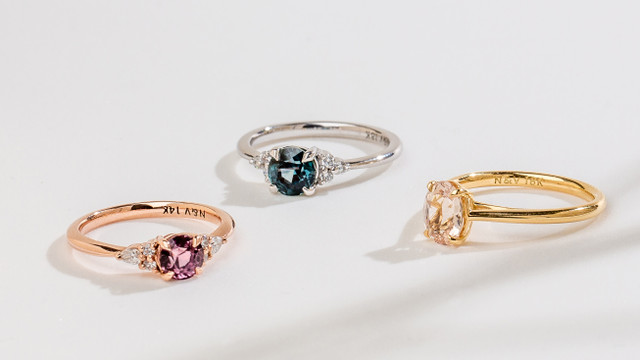If you're trying to keep your proposal a secret, we have a few suggestions to figure out which metal she might like. It can be a great starting point to see what colour metal your partner wears already. If she often wears yellow gold jewellery, it's a safe bet that's her preferred colour. If your partner wears mixed golds and silver toned metal, she might like either. If she has no preference then it can be a great idea to choose the metal that best complements the colour of your sapphire.
Of course if you’re really unsure we always suggest asking her friends or family, as there’s a high chance she may have told them already what she likes!
What Colour Metal Suits my Sapphire?
While metal colour is usually chosen as a personal preference of the wearer, on occasion you may select the metal based on what tone complements the sapphire colour. Depending on the colour of your centre stone, certain metals accentuate the gorgeous tones in your sapphire, making them appear more vivid and vibrant. Rose gold is perfectly paired with peach and pink sapphires as it helps to enhance the rosy pink colour of your stone, while yellow gold can add warmth to a more champagne apricot sapphire. Teal sapphires pair beautifully with yellow gold, helping to highlight flecks of blue, green or yellow within your sapphire.
White gold has a slightly bright undertone that helps enhance the cooler tones, especially in deep blues and teals. A white gold band can also help to enhance the lustre of a white sapphire centre stone. In the same way that side diamonds can completely change the look and feel of your overall ring design, so too can the metal you choose. Being able to visualise your options is always the best way to make a decision, which is why we always show each sapphire set in all metal colours, so you know the right choice when you see it.

What’s the Difference Between 9K, 10K, 14K, 18K Gold?
For engagement rings we always recommend 18K Gold or Platinum for a beautiful, durable and long lasting metal.
To understand what makes 18K a great choice for your engagement or wedding ring, it’s important to understand the composition of the metal. Your jewellery is typically marked with one of the following, 9K, 10K, 14K and 18K, which indicates the percentage of pure gold.
Pure yellow gold is a relatively malleable and soft metal, so in order to make sturdy, long lasting jewellery it is mixed with alloys (silver, copper and zinc). For instance, 18K Yellow Gold is 75% Gold and 25% alloy, while 9K gold is 37.5% gold and 62.5% alloy. Rose gold is gold mixed with copper alloys, which is what gives it a beautiful rosy hue.
What’s the Difference Between White Gold and Platinum?
White gold is gold blended with nickel and zinc to obtain the bright white colour. It’s important to note that in order to maintain its bright colour and lustre, white gold needs to be re-plated with rhodium every couple of years.
Platinum metal is another wonderful option for those looking for a white finish, with a hard metal that will be resistant to the everyday wear of an engagement ring. Slightly less bright than white gold, platinum has the added advantage that it does not require any plating or maintenance, making it a popular choice if your budget allows the slightly higher price.
